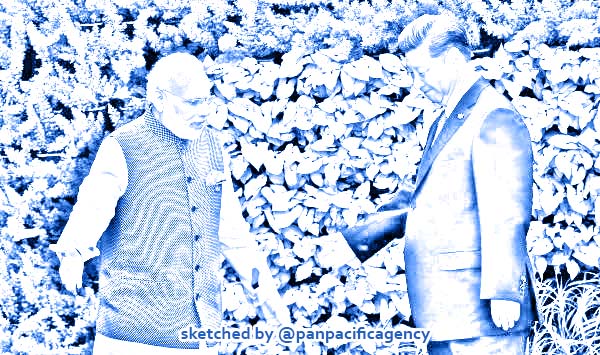[Analytics] Cracks in Xi and Modi’s shared world vision

Indian Prime Minister Narendra Modi and Chinese President Xi Jinping leave after a group picture during BRICS Summit in Benaulim, India, 16 October 2016 (Photo: Reuters/Danish Siddiqui). Sketched by the Pan Pacific Agency.
Indian Prime Minister Narendra Modi and Chinese President Xi Jinping met in Chennai, India from 11–12 October 2019 for their second so-called ‘informal summit’. With Modi enjoying his recent general election victory and Xi continuing to exert his domestic dominance, these annual meetings are gaining greater significance. They offer an opportunity to scrutinise the geopolitics of China–India relations. They also provide potential indicators of how the two leaders view the current world order and raise the question of whether there is real impetus for warmer ties. Chris Ogden specially for the East Asia Forum.
Official reports from both countries give evidence that the worldviews of Modi and Xi are increasingly coalescing. The relaxed and casual atmosphere of the second informal summit allowed them to focus on the discussion of longer-term imperatives. Such a personal environment was free from the formalities of traditional diplomacy, official announcements and any potentially constraining formal memorandums of understanding. The leaders stressed that ‘the two countries should not only face history, but also transcend the past and open up the future’. Xi and Modi openly stated their desire to ‘create a beautiful future for India–China relations together’.
Narratives in the official reports also point to a degree of strategic convergence. Xi stressed that China and India are both at a critical stage of national development and national renewal, given their growing populations and emerging economies. Evident too is a sense of strategic efficacy with officials stating how ‘the two countries should help each other to accomplish their respective goals and “light up” each other’ en route to their re-emergence and rejuvenation as modern-day great powers. The personal chemistry between Modi and Xi will help in achieving these goals.
But the off-the-record context of the summit allowed the idealised strategic aspirations of both sides to overshadow strategic realities. While both states strive for a peaceful, secure and prosperous world in which all countries can pursue their development within a rules-based international order, such sentiments are actually very situation specific.
Although both sides want an international system with the United Nations and the World Trade Organization at its core, major differences counteract this shared vision. Beijing is unwilling to allow India to join the Nuclear Suppliers Group as this would be damaging to its long-standing ally Pakistan. Similarly, New Delhi will not join the Belt and Road Initiative as this would undermine its regional standing and also enable a China-centred and tributary-based new world order.
It is more than credible for Modi and Xi to state that their countries’ ‘bilateral relations have transcended the bilateral scope and are of great and far-reaching strategic significance’. But the generalities of the second informal summit effectively brushed over other important differences.
Emblematic of these was India’s recent withdrawal from negotiations to form the Regional Comprehensive Economic Partnership (RCEP), the proposed free trade agreement between the members of ASEAN, Australia, China, Japan, New Zealand and South Korea. This decision was a result of India’s fear of foreign competition and potential economic domination by Chinese manufacturers. But it also lost India access to a market eight times the size of its own economy, or about a third of total global GDP.
Although the second informal summit professed to enhance strategic mutual trust between China and India, such negative events point to deep-seated strategic distrust that has effectively overridden mutual economic gains. India’s withdrawal from RCEP also severely undercuts arguments concerning the valuable rapport built between Xi and Modi, as well as mutual pledges made in Chennai to proactively enable an open, inclusive, prosperous and stable environment in the region.
The true value of the China–India informal summits remains to be seen. Any official pronouncements from both countries need to be taken with a liberal pinch of analytical salt. The positive sentiments emanating from both sides may point to a longer-term merger of the two Asian behemoths’ core strategic ambitions regarding their places within the current world order. But substantial and formalised agreements are needed to make this a reality. Other negativities also loom over their relations, including border disputes, trade imbalances and frictions relating to Pakistan and Tibet.
Still, the ties that bind India and China ought to be far stronger than those that push them apart, with both sides keen to modernise and develop through enhanced trade and multilateral linkages. With Modi and Xi set to lead their states for years to come, whatever personal chemistry there was at the second informal summit will be vital for creating a solid bedrock in their relations in the decades to come.
Chris Ogden is Associate Professor in Asian security at the School of International Relations, the University of St Andrews. His latest books include A Dictionary of Politics and International Relations in India (Oxford UP, 2019) and A Dictionary of Politics and International Relations in China (Oxford UP, 2019).